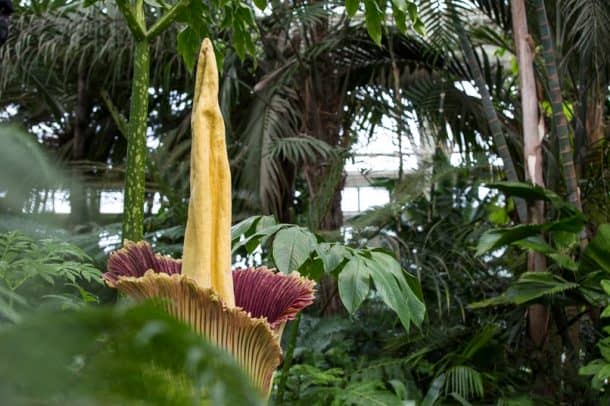The influx of thousands of people towards the New York Botanical gardens is very understandable. Something that hasn’t happened for decades is about to occur! And despite its repellent and grotesque stench, its attraction due to its rarity is astonishing.
Many more people are tuning in online to watch a flower bloom as well. The flower when fully bloomed smells of rotting flesh, but people are rushing in to get a whiff anyway as it is a rare event indeed. This is because after the flowers are planted they take from 7 to 10 years for blooming for the first time. Subsequent blooms take just as long. And the reason why the plant smells so bad is because when it opens, it tries to attract as many bugs like flies, beetles etc that can help it pollinate other plants. Only those insects are attracted to the awful smell which usually lay their eggs in rancid, rotting meat. Sounds so nice!
You can judge its rarity from the fact that it’s has been more than 80 years since the New York Botanical Gardens has had a fully bloomed corpse flower. Because of this reason, Botanical gardens around the country and many private collectors cultivate the plants while counting days to their blooming.
It usually takes around 48 hours for the blooming process to finish, and the NYBC has set up a live stream for everyone to witness. So if you are a plant enthusiast or are just interested in viewing this spectacular sight, you can follow the livestream link given below! And if you are tough enough to bear the stench without puking, you can go to the NYBC in the Bronx to check it out.
Here is the link to the live streaming:
Titan arums is scientifically known as Amorphophallus titanum, and commonly is known as the “corpse flower”. The Royal Botanic Gardens, Kew, hosted the first titan arums to bloom in 1889, and the boast that the corpse flower is by far one of the largest flowering structures with one of the foulest odours in the plant kingdom. As mentioned before the odor is basically to attract insects that feed and/or breed in carrion and dung so that they can be carriers for pollination for the plant. The plant requires tremendous amounts of energies in emitting this smell, so it is more like coming in infrequent waves rather than constantly being emitted or present.
This ten-foot-tall flower with a horrific odor is surprisingly blooming at six or seven places along the east coast all at once! According to The Guardian, that corpse flowers are expected to bloom soon in the states of Washington, D.C., Bloomington, Indiana, and Sarasota, Florida. This is after the blooms earlier this year in Chicago, Charleston, Illinois, and Winter Park, Florida. Considering the fact that only 157 recorded corpse flower blooms were recorded in the time between 1889 and 2008; this indeed is an unusually large number! The question is why is it happening all at once?
Typically, plants flower around the same time to encourage cross-pollination, particularly plants that are slow to mature. But this does not make much sense for the corpse flower, which is only restricted to the territory of the rain-forests of Sumatra and is a very rare flower, with their pollinators-of-choice generally not traveling too far. So much so that the U.S.-based flowers may even come from the same seed distribution, which makes them each others’ cousins!

There’s some evidence for the fact that the synchronized blooms came from the same seed distributions which were carried out between 2002 and 2008, thus increasing number of corpse flowers in U.S. greenhouses and botanical gardens. But unfortunately, we have very minimal knowledge about the origins these flowers, so the cousins theory is just a theory and nothing else.
Of course, looking at the commercial and aesthetic side of the flower, the increased commonality of corpse flowers can be explained. The Corpse flower has become a great visitor attraction for the botanical gardens, thus attracting thousands of ticket-paying visitors who normally would never come.
Witness one of the corpse flower blooming earlier this year at Marie Selby Botanical Gardens,
So hurry up and check out this smelly miracle of nature, with your eyes and if possible with your nose, before it’s too late!
Have anything more to add to this article? Comment below!


